Do you have an anxious cat and want it to become more trusting?
Well, first things first: You are not alone the issue you are facing is not unusual! Many cats are shy or nervous and react anxiously in certain situations.
Within a natural environment, anxiety has a vital function:Fear induces flight, threat induces aggression, both serve survival. Whilst bold or daredevil cats do not enjoy a high life expectancy, careful and alert behaviour acts as a life insurance for others. It’s better to pull back once in a while and to always stay alert to potential danger waiting around the next corner.
Fear as such is useful and serves the survival of the species.
However, if fear becomes a habit, we are no longer dealing with self-protection. In those cases, harmless incidents or encounters can become triggers, igniting violent reactions or attacks which make life harder for both cat and human. This can even lead to complete withdrawal, during which the cat may reject its food and stop interacting with fellow cats.
Many cat carers find themselves devastated and at a loss.
The typical signs of anxiety are:
- shock-induced paralysis
- flight
- cowering position
- tail flat alongside or underneath the body
- tail bushy and a tad bent
- ruffled fur, standing on end
- hissing
- growling
- wide opened eyes
- widened pupils
- flat, bent ears
- trembling
- rapid breathing
- vomiting
- release of urine or faeces
Why is my cat anxious?
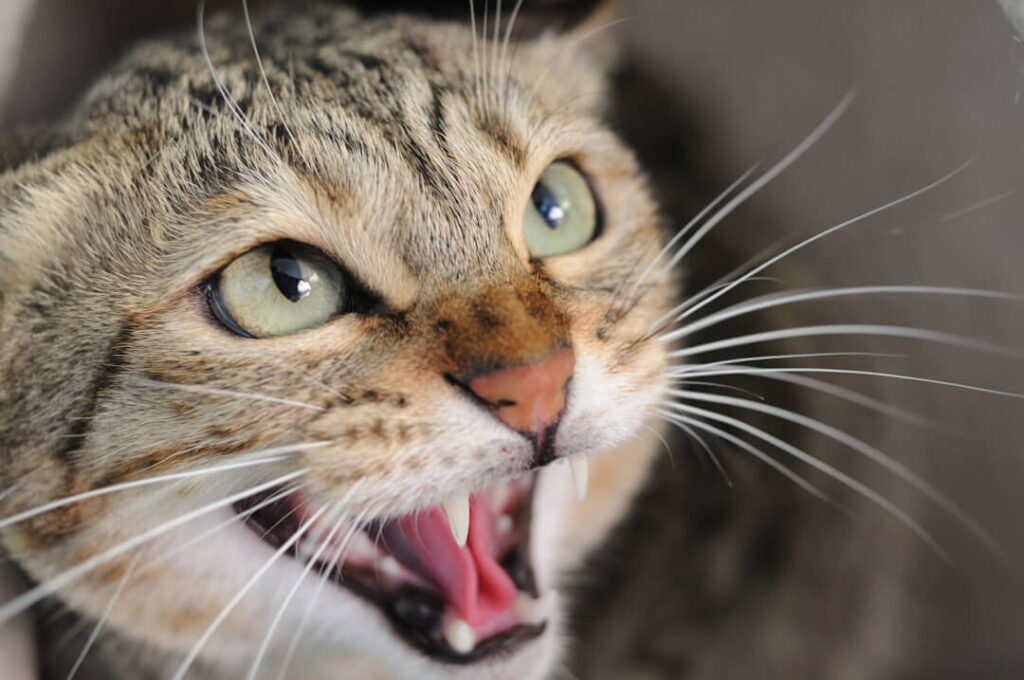
Fear has a lot of facets. On a wide scale, ranging from insecurity to panic, anything can apply. These feelings have one thing in common, though they are perceived as negative. Cats who have been self-confident in the past, can become fearful as a result of certain events.
For us it often seems as if nothing big has happened – for a kitten however, it may be the end of the world! To be able to help your cat, you need to analyse the cause: What could have induced the anxiety? Often, it is not easy to recognise what the trigger is, or was.Maybe your cat has lived through a bad experience and is afraid that it might reoccur.
Fear induced by negative experiences
You know the phrase once bitten, twice shy – if you’ve touched a hot stove you won’t do it again! The same goes for your cat! Your cat wants to avoid the recurrence of bad situations. Fear is a biological principle for self-preservation, which tells the cat:
“Avoid danger and pain – it could be your very last experience! You do not want this, because you are here to procreate and maintain the species.”
And because cats – unlike humans – trust their instincts, they are clever and fearful.
Negative experience with humans
Cats who have endured bad experiences can be very suspicious: This concerns strays as well as house cats who may have experienced aggression at home. Many a cat holder never wonders what a species-appropriate “handling” of their cat should look like – malicious intent is rare, many simply don’t know better.
Either way – what some cats endure is a very sad chapter and sometimes exceeds our worst imaginations.It is a miracle that cats can actually learn to trust humans again by experiencing a lot of love and patience.
Negative experiences with vets
“Oh if I could hermetically shut off all orifices…” many a cat might think during a visit at the vets. “First they cram me into a tiny basket inside of which I cannot even turn around; then they rudely drag me out again and my body is examined all over in a bright lit room. And all this in front of complete strangers!
And then there is this horrible smell! A smell of fear and pain – here they torture you – maybe it will end up really painful? Or do I have to stay here again? In such a cold dungeon with just food and water. The last time it was horrifying! – Just wake me when it’s over!”
No matter how you do it – an appointment at the vets is always a more or less gruesome experience.
Negative experiences with transport boxes
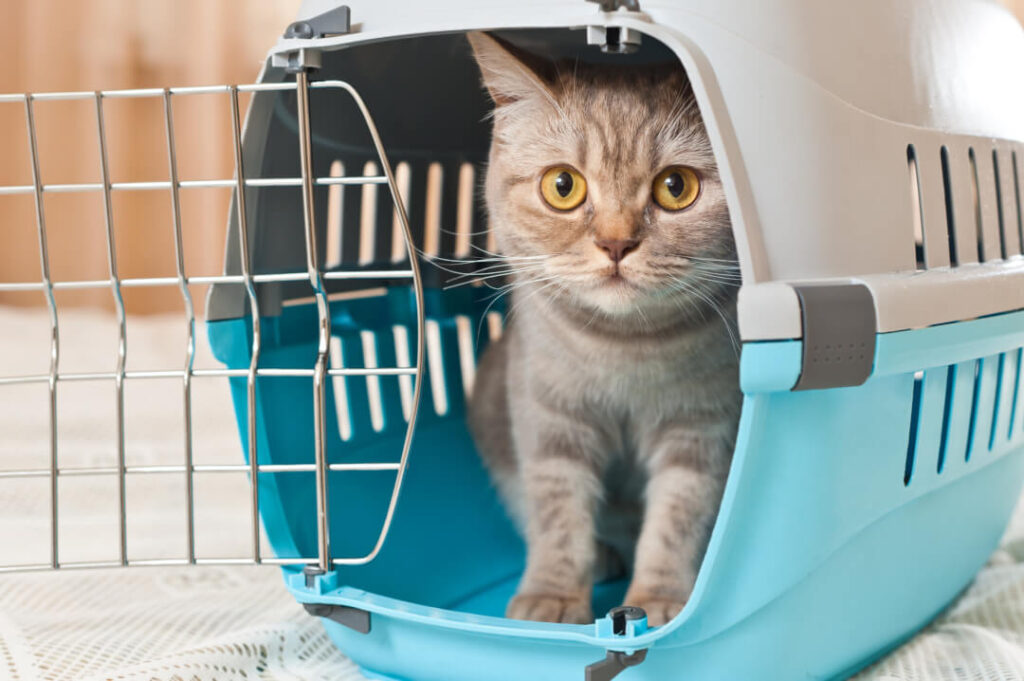
“Sooner a camel would pass through a needle”…If your cat has any bad memories concerning a transport box, it will become a real challenge for you to get it anywhere near the intimidating thing again!
In itself, a box usually doesn’t present a problem: Cats love caves! Cartons of any kind will be happily adopted by your cat; just unpacked the new food processor? Whoosh – the packaging is now occupied. And it may well be narrow – a cat squeezes through any gap – and if it has to be, into a shoe box!
However, a transport box is a reminder of unpleasant experiences: Getting mobile has effects on a cat which it rarely enjoys.Agitation, stress, the unknown – all experiences which your cat would like to avoid. By the way, your cat will smell what’s up even before you get the box out – and suddenly will be nowhere to be found…
Negative experiences during a car journey
One cat doesn’t mind it, another hates it. Little children whine on longer drives: “Are we there already?” – “I am thirsty!” and so on. So does your cat!
– But in its own way: Protest songs are intoned, all of which are piercingly loud and full of resentment. Too long, too hot, too little control – just imagine yourself in your cat’s situation.
Also, a cat does not know how long the trip will take or where you are heading. There is restricted view from inside a box. Maybe you have to slam on the breaks and your cat will be thrown about. Or it will get a queasy feeling during a car drive: Some cats can’t deal with the rocking movement and that means a mishap is likely to occur…
Tip:
Only drive your cat around when there is no other option. Feed it for the last time around 6 hours before start, and better not in between!
Fear of the unknown
Your cat is a creature of habit – literally! It does not appreciate change. Permanently changing circumstances equal stress for your cat. This is logical, as cats always check their territory for dangerous signs and can only relax when everything is well and under control – otherwise high alert is the given state. For you, new furniture or the new blender might be pleasant additions – for your cat however, those items are “intruders” into their safe habitat which must undergo a thorough examination. Such behaviour may sound paranoid, but for a cat it is normal and completely justified.
Moving anxiety
New home, new happiness? Not for cats really. Especially if they have trouble finding their way around in the new place: “Where is my beloved scratching post? The new one does not smell like me and it is sitting in the wrong spot, not where I would like it to be. And anyhow – everything here is so different. Nothing is the same as before! And my human is only busy with packing and unpacking boxes! When I turn up, I am being pushed aside, as if I were one of the boxes!” All of the latter can get on your cat’s nerves, a lot.
Fear induced by strangers and other animals
For cats, fear is a survival instinct. A bold, fearless cat – even though cats are known to be curious – will be easy prey for predators or assault. Consequently, it is better to flee first then check the situation from a safe spot. Your cat may live with you in the safe surroundings of your home but even a domestic cat is still a wild animal, with basic instincts.
Suspicion towards unfamiliar humans and animals – even on velvet paws – is completely justified. From a “domestic” cat however, the exact opposite is expected: It is supposed to be friendly, cuddly, and affectionate right from the start.
Fear induced by unfamiliar sounds
Cats are excellent hunters. Their senses are highly refined. If this wasn’t the case, they would not be successful in their search of prey and simply starve.
Just imagine having an amplifier inside your ear which makes everything more audible and louder. Loud and unfamiliar sounds would definitely scare you as well.
Unfamiliar sounds are especially hard to classify: And there it is again – the fear of the unknown. What could this strange sound mean? A gigantic monster, ready to leap, or just a harmlesometimes, it is really hard to dispel a cat’s anxiety, especially if there have been traumatic experiences in the past. The overall behaviour in those cases is often hard to read, especially if the animal – seemingly out of nowhere – feels so threatened that fear turns into anxiety – one minute it is in cuddling mode and the next it bites and scratches you?
Remember, there is always a good reasonfor your cat to behave like this, even if it may not be obvious to you.
Habituation – Phase 1
You have a new cat and want it to settle in quickly? It is behaving anxiously and you would like it to trust you more?It is hiding as soon as you are approaching? Or even running away from you? – Do not take this behaviour personally and first and foremost, leave them alone!
Move slowly while you are approaching your cat. Allow your cat ample time to get used to to study and classify you. In no case try to trap or force it – this will be counterproductive: Your cat will completely hole up and be aggressive, because it feels threatened.
Create a stress-free environment
To cats, change is never a good thing. They love rituals, their habitual places, and cosy cat naps. All of this, however, is only granted if the procedures around them are known and remain the same. To increase your cat’s feel of ease, you can create little havens of peace – these may be elevated or cave-like spots where it feels safe, especially if “the outside world” does not seem entirely trustworthy yet.
You cannot keep away every day life entirely but you can avoid loud noises or stressful situations – this will help a shy cat immensely! Leave the rooms and allow your cat to explore the new territory: That way it will be easier to check the terrain, make it it’s own and feel safe. Only when it is absolutely clear that there is no imminent danger, your cat will begin to trust and allow (more) proximity.
Arrange for sufficient free space and hiding spots
Provide possibilities for withdrawal so that your cat can leave a situation which seems “too tight”. Anxiety normally produces a flight reaction – a safe hiding place will therefore relax the situation. This is your cat’s retreat waiting for it when it feels threatened and allowing it to feel at ease.
These are also the places for a healthy snooze or a cat nap. An exclusive hiding space. Here your cat can feel at ease and relax completely. Cats love elevated hiding spots. However, anything resembling a cave will also be appreciated. If there is room under the bed or a niche between two cupboards, these might become favourite spaces as well. Your cat will pick its own favourite spots though, just give them plenty of options by leaving the hiding spaces clear of clutter.
Allow for peace and quiet
Humans often think it helps to look after someone permanently – to a shy cat this can mean hell. The more you start coddling your animal, the more it might run off. Tracking your cat down or playing with it continuously will not help the case.
Cats do not understand these therapeutic approaches and will become even more invisible.The best option is to pursue your own daily tasks: Proceed as always, but take care to avoid the loud noises – this phase should be free of vacuum cleaners and other loud household appliances – and don’t worry, this will only last until your cat feels more at ease in the new surroundings.
Give it time
Baloo from The Jungle Book always knew that the “bare necessities” include calm and ease! Give your cat all the time it needs. This can be entirely different for each cat – one may overcome it’s reserve more quickly than another. You should create a peaceful environment for your cat throughout this phase. Avoid – as much as possible – stress and noise.
Give your cat time and space – each positive experience will strengthen it and boost self-confidence: “Aha! Actually, nothing bad happens when I leave my hideout!” And so the first step has been made.The more positive experiences your cat enjoys, the more self-confident and trustful it will become. Fear can first turn into reluctance, then into confidence and ultimately into trust.
Habituation – Phase 2
The first step has been made: Your cat is not hiding any more but has summoned up all it’s courage and actively entered the new territory? If so, do not make the mistake to follow it, as in: “Ah, here you are finally! You were looking for me, were you?” This could mean a complete setback! Your cat will very likely choose the option of flight again and stay in it’s hideout even longer than before, making things worse for both of you.
At this point, analyse the body language. You are already aware what your cat looks like when it feels anxious: Fur standing on end, arched back, ears flattened to the side and maybe a slightly bent tail. The pupils will be extremely wide.
Try to interpret your cat’s body language in the right way
By using its body, your cat will tell you all you need to know.
Pay attention to signs: What position are ears, tail and whiskers in? What facial expression does it show? Often, distinctive sounds will accompany these signs…



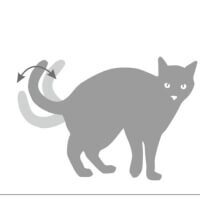
Use language and expression for reassurance
When you speak to your cat, stay calm and relaxed and use a lower pitch of voice. Social mimicry works with people copying the body language of their interviewer so that their counterpart registers them as sympathetic. With cats, this rarely applies – it is obviously hard to mimic your cat as you are lacking the respective features to do so! (Even though, the most curious approaches have been tried out…)
You are a human being, but you can show your cat that you mean well by way of a unique, “human communication”, thus putting your animal at ease. So – in case your cat is frightened – what can you do to calm it down by using your own body language and facial expression?
Do not stare at your cat
An eye for an eye – in cat speech: If you have observed a cat’s behaviour among its fellow cats, you will notice that staring means that either an attack is soon to follow, or at least that the situation is worsening dramatically.
Direct eye contact among cats is a sign of dominance. “Who do you think you’re talking to? – Want to challenge me?” However, the goal of this behaviour is to actually prevent a fight by threatening the enemy – in the best case, the opponent cannot stand the stare and will retreat. So, if you fix your cat with a stare, it could – in the worst case – think an attack is imminent! Or that you want to challenge it. This may be taken as a threat, leading to retreat. Instead give a frequent wink – which, in cat speech, equals a friendly smile.
Habituation – Phase 3
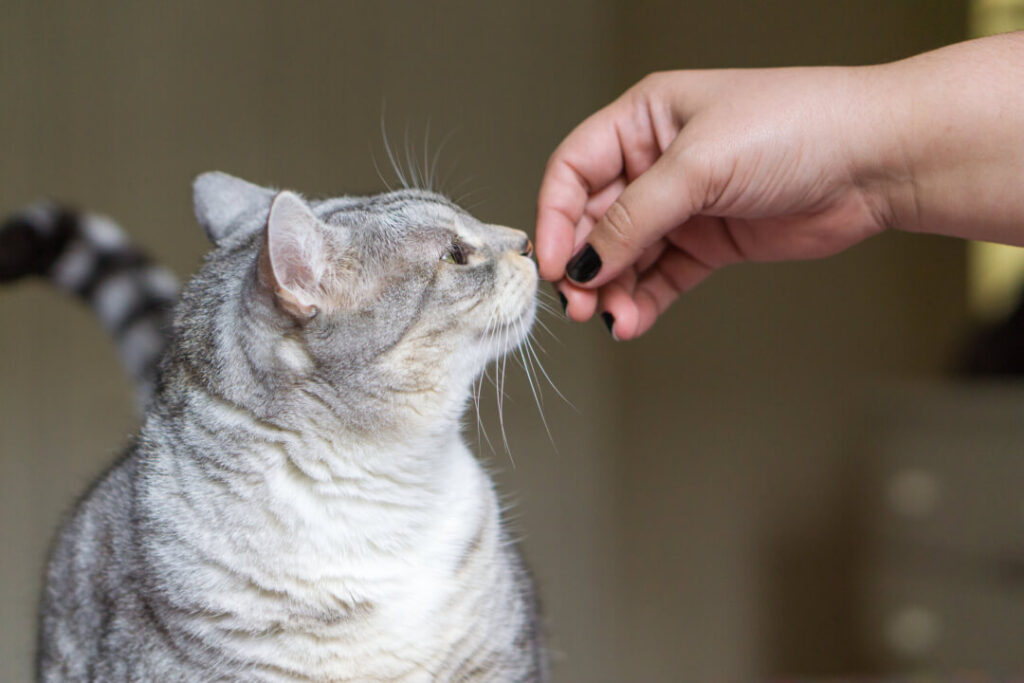
“We have contact” – though not, as Paul Hellyer recently claimed, with Aliens. But even so for a cat lover this can equal Christmas and Easter combined: The cat has come out of its cover! Now it’s almost done: You have put your cat at ease. The shy cat is beginning to trust you. Now you can work on connection. However, here the overall motto applies again: Do not rush anything! Do not apply pressure! Always let the cat make the first move! Your cat should approach you first, not the other way round. Once your cat is ready, an invitation to more closeness will follow…
Proximity is up to the cat
Stay calm and wait for your cat to come to you. Let it sniff you for a bit – you may also extend one hand very slowly – but always cautiously and in slow motion. If your cat withdraws, leave it at that for the moment. Maybe, the cat will cautiously move along your leg or rub its cheek on it – now there is reason to celebrate! This means, that you have just been “tagged”.
With its smell, the territory has been marked –“my human!” The smell does not only indicate ownership but also sympathy. By doing this, your cat demonstrates affection. However, do not answer with a spontaneous caress but first let it sniff your hand so that your cat can acknowledge it and accept your touch.
Start cautiously
To touch with no prior announcement is a no-go! This is not even liked by trusting cats and in no way accepted by those who are still shy! However, there is a means to open the heart (more quickly): TREATS. Many a convinced “cuddling grouch” will quickly soften up if the caressing hand also holds a treat.
When your cat comes near and even allows you to touch it, have a reward at hand. This will leave a lasting impression positively reinforced by the treat. Who knows? – Maybe your little pelt-nose will ask for the next cuddle quicker than you think! But always stay gentle – never overdo it! When you realise your cat has had enough, don’t pressurize it for more.
Strengthen the bond through play
Make time for playing with your cat daily. This will strengthen your relationship. Choose games that your cat especially likes. Playing together is not only improving your relationship it also means your cat can live out its instincts and enjoys sufficient exercise. Therefore, play is a must for house cats! Here, both incentives and entertainment are provided and this is at least equally important as food and water; cats with no chance for interaction wither away in no time.
The best policy is a regular playing hour as part of your daily routine, preferably at a time of day when your cat feels the most energetic and motivated.
If nothing works
Sometimes, it is really hard to dispel a cat’s anxiety, especially if there have been traumatic experiences in the past. The overall behaviour in those cases is often hard to read, especially if the animal – seemingly out of nowhere – feels so threatened that fear turns into anxiety – one minute it is in cuddling mode and the next it bites and scratches you? Remember, there is always a good reason for your cat to behave like this, even if it may not be obvious to you. Please do not take it personally and never punish your cat – because its behaviour is merely the sum of its experiences and fears. You have tried everything and even loads of love and patience have been of no help?– then you may want to try homeopathy or pheromones.
Bach flowers for reassurance
If homeopathy is of help, or not, is a matter of belief – the cat holder who swears on conventional medicine will simply frown upon it and choose something else. Then again, people who believe that homeopathy is an approach that helps humans may be inclined to give it a go with animals as well – and consider it as an alternative.
The big psychological question “does an animal have a soul?” may have to remain unanswered at this point. However, anyone who, like founder Dr. Bach, thinks that body, soul and mind should form a harmonised unity, may try Bach Flowers Therapy. A single essence or a specially mixed solution may be of help to your cat.
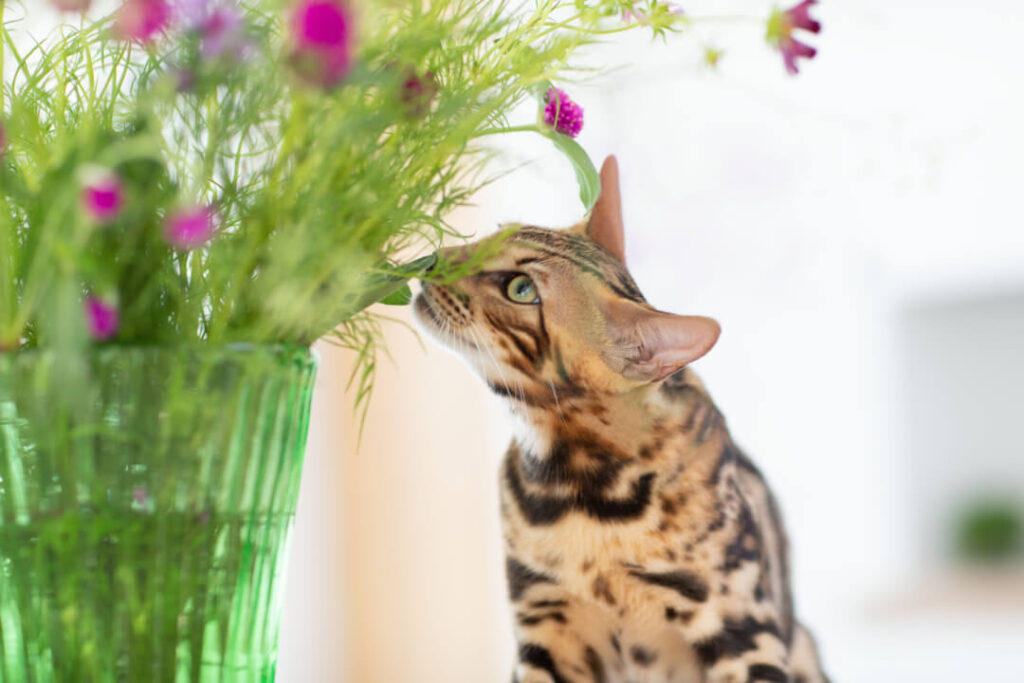
TIP:
Anxious cats: Aspen, Mimulus
Aggressive cats: Beech, Cherry Plum, Holly, Impatiens
Have a look here , we have already introduced Bach Flowers Therapy.
Introducing cat pheromones
Quotes should be avoided – true. But this one fits the context beautifully and the inclined blog reader may forgive me:
“There are more things between the sky and earth than school wisdom will let you imagine”
– Yep! says the cat – while the quote is by William Shakespeare – as for velvet paws this is old news: Cats communicate on different levels from the start, which to us are neither visible nor explainable in terms of bio chemistry. Pheromones are chemical substances produced by cats. They serve communication and affect the behaviour. Cats produce these neurotransmitters in various glands. Each odour has its own specific meaning and will be left on strategic spots, transmitted via the face (chin and cheeks), paws or urine by the cat.
Pheromones are divided into various fractions: Face pheromones are spoken of as either “F3 fraction” or “feel good pheromones”, and the “F4 fraction” – or “social pheromones”. These facial pheromones can also be produced synthetically. You can spray them onto single items or put them to use in rooms by means of a plug-in atomiser.
Well and good – you may think – but where can I get the relaxing pheromones? Scent carriers are commercially available: FELIWAY
Remember:
Use the vaporiser preferably in the room your cat like to stay in the most, at least for a period of four weeks.
Visit a vet or a cat psychologist
The “tough cases” – those poor creatures who have been through a lot – may not accept help easily. If fear rules a cat’s entire life, you may want to consult a specialist. This can either be a vet or a cat psychologist. A vet can check possible physical reasons and take a look at the cat’s behaviour. A lay person is not able to deliver such diagnostics – even if they are a brilliant cat person..
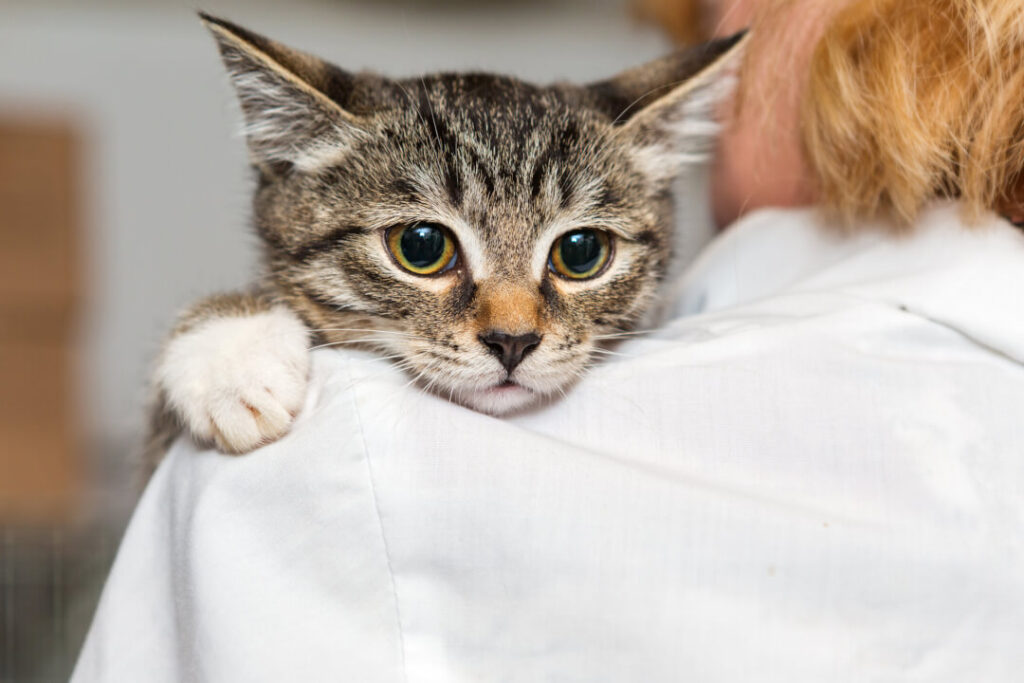
The view from the outside and the respective advice can sometimes work wonders: Many a symptom can even be quickly and easily resolved. If the reasons are rooted deep within the psyche, an animal psychologist can be consulted who might be able to suggest and support behavioural therapy.
Truth be told – there is no universal remedy that works for all cats alike; the individual animals are too different from each other. Each cat is marked by its own history – by its mum, the genetic code and the surroundings. The effort to make turn an anxious cat into a trusting one seems big, the problems at times insurmountable. – But it is worth it!
At the latest when your cat disengages itself from invisibility and is waiting for you for the first time, its tail bolt upright: You give it a gentle try and pet its head – still unsure if it will run away in panic again – But this time, the cat stays put! – And nestles its whole body against your hand.
You’ve made it!
You now have a self-confident, affectionate cat who trusts you. A friend.
